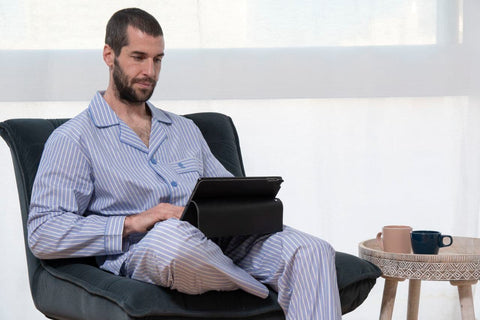An incredible but true fact is that most of the traditions of modern society have existed for over a century; and sleepwear and pajamas are no exception.
Throughout the rest of human history, sleepwear has varied greatly, regardless of whether one is looking at Western, Eastern, or ancient cultures. As a result of globalization, sleeping habits have adapted, and compared to the past, significantly smaller differences in sleepwear can be observed. Here, a brief history and evolution of pajamas will be presented.
The Private Past of the Pajama
Much of what history teaches is based on things that have been left behind: artifacts, paintings, songs, and more. However, sleepwear was considered a private matter: any type of sleepwear was meant solely for the eyes of the user and their family. Because of this, there are few direct examples of what pajamas would have looked like five hundred years ago. Fortunately, there are many clues that can help imagine the pajamas of the past.
In the Middle Ages, most pajamas were bulky with simple embellishments. They were made by the wives and daughters of the family, so it was important that they were easy to make. Only royalty and nobles wore pajamas that were more than just a simple long dress. Their designs were inspired by Indian, Asian, and Roman garments: large dress-shaped tunics with wide sleeves for greater comfort.
In fact, the word pajama is not of Western origin, but comes from the Hindi word "pae jama" or "pai jama," which means trousers and originated in the Ottoman Empire in the 13th century. Pajamas have traditionally been loose-fitting pants with a drawstring or cord at the waist. They were worn by both women and men throughout the Middle East and South Asia, including Bangladesh, Pakistan, Iran, and southern India.
They were fitted throughout the leg or wide at the waist and fitted at the ankles. The pants were generally paired with a belted tunic that reached the user's knees. This combination was considered the best way to feel comfortable and clean at home and while sleeping. In the 14th and 15th centuries, Europeans discovered pajamas from these cultures and adapted them to their climates. By the 17th century, almost all Europeans were wearing a type of pajama similar to those worn in the Ottoman Empire.
The Invention of the Sewing Machine
It wasn't until the Middle Ages that pajamas really became fashionable and began to vary. The reason for the emergence of the first forms of modern pajamas was the combination within Western civilization, over the long term, of cold weather and the advent of the first forms of modern fashion.
Until the 18th century, most pajamas were simple long nightgowns. Perhaps the most important innovation for the pajama industry was the invention of the sewing machine and a shift in Western culture: clothing was increasingly less sewn by oneself, but purchased ready-made in stores; this concept did not exist before the 18th century.
For the next 200 years, the style of the most popular pajamas was largely determined by what culture considered "right," "wrong," "moral," or "immoral."
Sleepwear for Men
From the early 17th century to the mid-19th century, nightgowns resembled day shirts, with a lapel collar and deep neckline. More sophisticated nightgowns were decorated with lace on the sleeves and neckline. It was not until the late 19th century that nightgowns made from various fabrics, such as flannel, percale, cotton, linen, and monochromatic or colored silk, were offered.
Since the turn of the century, garments that reached the ankles were called "nightgowns." There were also longer variants that reached the floor and were known as "night skirts." In the first quarter of the 20th century, nightgowns and night skirts gradually went out of fashion and were replaced by what is now known as pajamas.
Sleepwear for Women
Men decorated their pajamas long before women did. While the gentlemen of creation resorted to lace and embellishments, women opted for simple and voluminous dresses or nightgowns. The traditional nightgown was similar to the Indian banyan or the Japanese kimono and resembled a dressing gown or a calf-length coat with a thin belt or ribbon around the waist. Until the 20th century, nightgowns offered very little variety. One of the reasons women experimented with pajamas so late was the patriarchal nature of Western society: many were afraid of appearing as suffragists or members of the suffragist movement of the late 19th and early 20th centuries.
In the early 1900s, Coco Chanel was the first designer to create attractive and elegant pajamas for women and to convince women that pajamas can be as comfortable and beautiful as traditional nightgowns. Women's pajamas were officially launched in 1909, but it wasn't until the 1980s that they topped nightgown sales.
The first version of this women's pajama was a combination of a nightgown and pants: the top had a high collar and buttons in the front. The pajama had soft ruffles at the knees and wrists. Later versions had wide bishop sleeves and a colored ribbon around the waist.
The Transition to Modernity
The transition to modern pajamas in the 20th century meant a departure from old habits and a liberation of female sexuality. Two major trends dominated the mid-20th century: "babydoll" pajamas for women (a sleeveless top that falls just below the hips) and men's pajama sets that replaced traditional men's nightgowns, with simple yet comfortable military clothing from World War I.
In the 1970s, more and more people began to wear silk shirts inspired by sleepwear from China and India. Women also opted for the unisex look by wearing the same combination of top and pants as men.
A Look at the Future of Pajamas
The history shows that sleepwear has remained unchanged for a long time. It was only with the invention of the sewing machine that variations appeared and a market for sleepwear emerged.
A trend that will continue in the future is the normalization of pajamas as everyday clothing, which can be worn both at home and in public. As traditional and formal norms loosen around the world, more and more people have the courage to wear comfortable clothing, and at El Búho Nocturno, an extraordinary variety is offered that combines quality, comfort, and varied styles.

